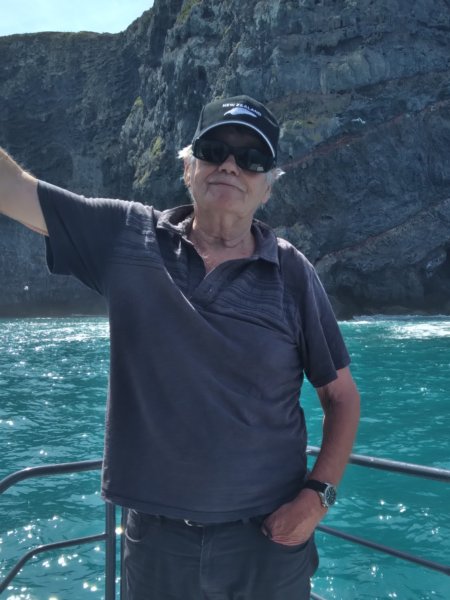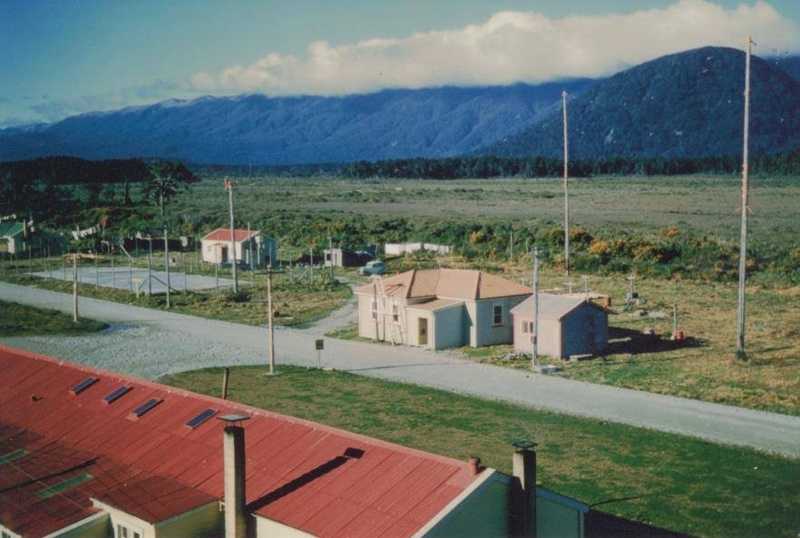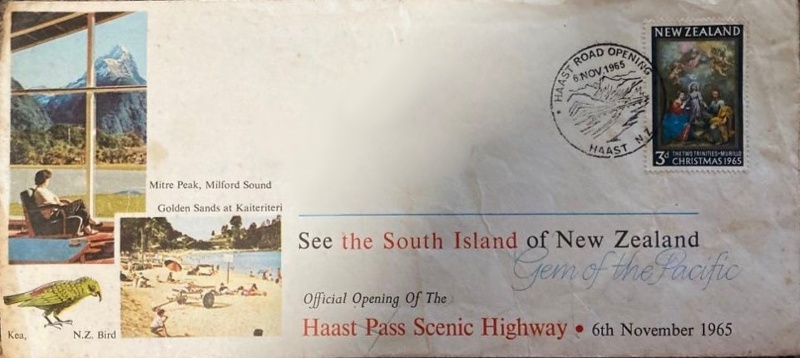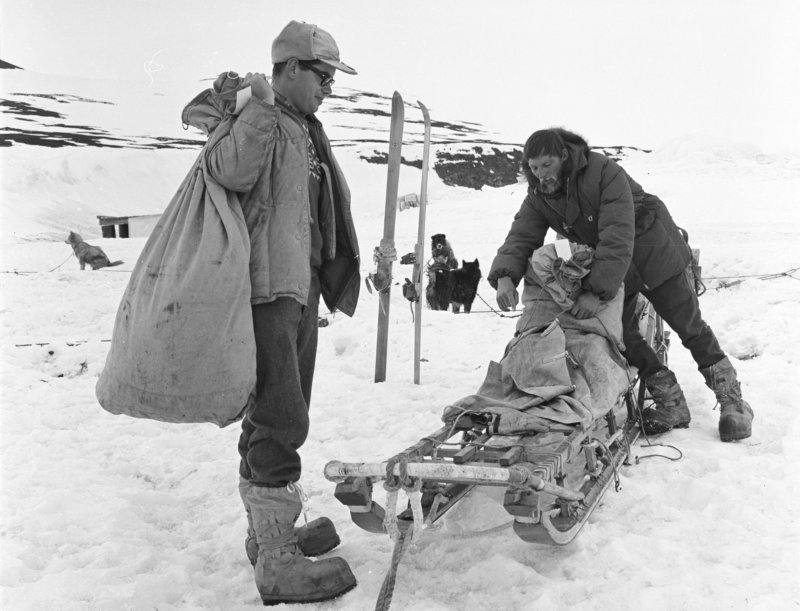The NZPO had two main branches - its technical role carried out by the Engineers Office and its 'front of house' role carried out by the Director General's Office. David Brown, now (2023) a gentleman of leisure, shares his memories of being NZPO Postmaster and Radio Telegraphist at outposts of Haast and Scott Base.

(Photo: David Brown)
Post Office Experiences by David Brown
Postmaster Haast 1964-1965 & 1968, and Scott Base 1966-67
Haast Radio ZLG - Scott Base ZLQ
My time in Haast ZLG started around 1964 until late 1965, I then returned for 12 months approx. in 1968. I went to Haast as a Senior Telegraphist and Postmaster having qualified in Morse and Teleprinter skills at the Post Office Training School in 1959/60.
Whanganui - Telegram Delivery Schoolboy
My Post Office career started in Whanganui initially delivering telegrams after school.
Aramoho Sub Office - Telegram Delivery and relief Postman
In January 1957 I joined, permanently transferring soon after to Aramoho sub office delivering telegrams and as relief Postman. Aramoho PO was a small sub office in Whanganui with the PO on the ground floor and Postmasters residence above like many suburban and country PO’s were. It was on the Morse network from CPO Whanganui along with a number of other suburbs. I was interested early on how Morse worked and I enrolled in night time tuition at the CPO to gain entry to the Telegraph Training School in Trentham. My interest was possibly sparked by dad being a radio ham and listening in to the other hams he talked to across the world and in Whanganui too.
Trentham Training School - Morse and Teleprinter Skills
In 1959 I went to Trentham Training School and passed Morse sending and receiving at 22 wpm (words per minute) I think and also learned Teleprinter skills which has been useful to touch type ever since.
Wellington TO and ITO - Telegraphist
After qualifying as a Telegraphist in 1960 I worked in the Wellington Telegraph office for a few months where I met a number of ex WW2 Morse operators and as ‘the boy’ I had to look after a number of circuits while sort of being supervised by them. After that I went into the Cableroom, which latterly became the International Telegraph Office (ITO) doing 24/7 shift work. This was mostly doing Teleprinter work using radio Teleprinter circuits to Sydney, London and Montreal.
The transmitting station was at Himatangi and receiving station at Makara. Whenever we had to change frequency because the signals were too weak for transmission we had to phone them to change frequency so transmission could continue or wait until conditions improved. It wasn’t until I went to Scott Base later that I was aware of the reasons why radio signals were lost sometimes because of disturbances in the Ionosphere with sunspots etc.
Doggo Shift
Whenever we worked the ‘Doggo’ shift which usually was midnight to 0700 often there was a period between 0200-0500 when the radio signals dropped out and work stopped until the signals were strong enough for work to restart. Usually there were 2 Telegraphists on duty and we would pop around to the Social Room and play Snooker before the cleaners came in. I am happy to admit I did get very good at snooker after a while and had many good snooker and pool sessions for many years after.
Wellington Domestic Life
After returning to Wellington from Haast I was also doing Morse work with the Pacific Islands Niue, Rarotonga, Apia, Noumea and Chatham Islands to name a few. I was very impressed with the skills of their operators who could receive much faster than I could.
At the time I lived in the hostel at ZLW (Wellington Radio) and had many long walk down the Tinakori hills and Northland through the Botanical Gardens or Bolton Street Cemetery to work at the CPO (Chief Post Office) and by mostly bus back to the Northland terminal to ZLW. I did occasionally walk back from the CPO but not very often. The meals were provided in the dining room there by a Dutch couple and the cost was included in our weekly hostel rent. Sometimes the staff from ZLW had a meal there too.
Haast Post Office - Postmaster
Early in 1964 (or possibly late 1963) before the road south was open I flew from Hokitika to Haast on a DH89 Dominie aircraft piloted by Brian Waugh, a West Coast Airways pilot. Brian was an excellent pilot and very professional (ex RAF). The aircraft ZK-AHS is at MOTAT now and was ideal for sightseeing with wide windows and only carried about 6 passengers, mail and freight. I remember passengers had to be weighed as well as their luggage and freight on these big scales to balance the aircraft I think, so that was an interesting start.
The service operated on weekdays, weather permitting and carried PO mail each way too. On occasions because of inclement weather the mail didn’t get through for up to a week so occasionally a Saturday or Sunday was required to be worked when there could be up to 12 bags of mail to sort. Flexibility was the order in working hours for radio work and operating the telephone/toll service.
A number of emergency flights were also carried out sometimes in very bad weather. Unless one has lived in this area for a long time it is difficult to imagine the atrocious weather that exists at times in this part of the country and it remains a huge credit to the pilots and road crews who worked there. Sadly a number of pilots perished because of the weather. There is nothing quite like heavy rain in South Westland.
To a young guy from Wellington and raised in Whanganui, arriving at Haast was a huge adventure and experience. It didn’t take too long to be introduced to the township VIP’s such as the Ministry of Works (MOW) Engineer, local District Nurse, Policeman and DOC Ranger together with the Civil Aviation Authority (CAA) person I was working with. We shared radio facilities and meteorological reporting duties.
As Postmaster I was soon meeting local people who came into the Post Office daily including farmers, road workers, business owners, deer cullers, helicopter pilots, fishermen, white baiters and occasional back packers. On a couple of occasions I got a big surprise when a helicopter would land on the road right outside the Post Office and the pilot popped out to post a letter or call in to check his mail. On another occasion an RNZAF Sunderland flew low and noisily over the township and provided excitement for a weekend morning. The pilot’s family lived in the town and they were on a navigational exercise.
I was made to feel very welcome and during the first few months attended both the Deerstalkers and White baiters Balls which appeared to have a male/female ratio of approximately 50-1 or it seemed so anyway. These were mostly social nights with minimal dancing, mostly by married couples and a lot of talking and partaking of the odd ale or two. The supper was a grand affair with stacks of Crayfish, Mussels and Whitebait patties. There was also movies shown at the local hall and 16mm reels of film were airfreighted in weekly and shown on Friday and Saturday nights. I joined the small team of projectionists and there was bedlam if ever the film broke and had to be repaired or there was a power cut during showing, all in good fun though and service was usually restored eventually.
The township had a large diesel generator for the power supply which was run by the MOW. Power came on I think at 0600 and went off at 2200 during the week and later at weekends. Some people especially farmers and those further south had their own generator or they had to use kerosene lamps or candles. The PO had a backup generator in case the town one wasn’t on so we could still operate the radio circuits, toll exchange and CAA aircraft links.

The Haast PO photo shows the aerials to the right and generator shed.
The radio room is on the right hand side of the PO building next to the engine shed.
(Photo: David Brown)
My position of Postmaster included maintaining radio contact with Awarua Radio via Morse for telegraph traffic and we handled anywhere from 10-20 telegrams daily each way. These were mainly from local businesses, MOW and residents ordering supplies or other social contact type telegrams. Freight including groceries was trucked in over the Haast Pass twice weekly or air-freighted from Hokitika.
Because of its isolation there were often some light hearted moments I recall, including one resident living in the bush who had a cut down car with no roof, headlights that could be dipped with strings attached and pulled from the drivers cab and a crescent (wrench) for a steering wheel. Many vehicles didn’t have a WOF or were unlicensed and whenever a Traffic Officer visited the township from Otago the ‘bush telegraph’ always ensured some vehicles were well off the road before he arrived in town after a 2 hour trip. This was a very close community who looked out for each other.
There was a single wire (earth return) toll circuit that ran from Haast to Wanaka. This could be fairly unreliable and often had a ‘hum’ tone on it. It mostly followed the line of the unsealed highway but sometimes took off across country mounted on insulators nailed to trees around areas where the road was subject to slips. The line was easily knocked out by a pole being hit by a truck or car and in the winter several spans often came down with the weight of snow. Often the Faultman from Clyde couldn’t come in for up to a week and occasionally longer because the pass was closed.
So the radio contact with Awarua was essential to ensure reliable contact was maintained at all times. The telegraph service was ‘on demand’ basis so I would just call up ZLB when I had one or several telegrams to send. The service was shared with Milford Sound PO on the same frequency so at times because of heavy tourist type traffic between them and ZLB I had to wait for a break but usually wasn’t too long to wait. ZLB used to call up Haast/ZLG in the same way when they had traffic. Regular PO times 0900 – 1700 to Clear was mainly kept. ‘Clear’ usually meant I had to wait until 1715 at times so Awarua was sure there was no more traffic for the day coming off for Haast. This was normal practice in the day across all PO telegraph circuits.
There was a standard NZPO Morse key and there were two NZPO made grey transmitter tower units with one being a backup I think. These were approximately 4-5 feet tall and were maintained by the Radio Depot in Dunedin and a Tech used to come over every 10-12 months or so to service them and check over the aerials etc. We could if needed use one for Radio Telephone (RT) use in an emergency but this was rarely used as speech could break through local residents radio broadcast band and was all ‘open’ unlike sideband I used at Scott Base. The Ministry of Works and Civil Aviation also had RT service of their own too. On a couple of occasions I used to call up my Dad ZL2ACT at weekends and chat, but usually preferred phoning and RT was probably not permitted anyway.
The Post Office building Radio-room were shared with a Civil Aviation employee. He had to check the aerodrome daily and provide weather reports to Christchurch Airport 24/7 from 0600 to 1800. We shared reporting duties for the 0600 and 1800 reports on weekdays and alternate weekends. Whoever’s turn it was to do the 0600/1800 readings during the week also worked the weekend. The weekend readings were at 0600, 0900, 1200, 1500 and 1800 and observations included cloud types, rainfall readings, wind direction and speed, temperature, barometric pressure and sea conditions. The readings were then coded for transmission and sent by Morse to Christchurch Airport Coms. During thunderstorms it was very difficult at times due to crackling in ear phones to read incoming signals especially at 0600 to confirm or query messages. (This seemed especially so after a ‘night out’). I found observations very challenging initially but quickly learned and found it very interesting. I have maintained my interest ever since in the mysteries of the weather and cloud formations.
On my return to Haast later I was there for the Inangahua Earthquake in May 1968 and awoke early in the morning with the bedroom shaking, walls moving around and the aerial stay wires rattling above our wee house that was behind the Post Office building. I could hardly stand up when I went outside and was pretty shook up that day but no damage fortunately. When leaving Haast months after and driving through the Buller Gorge there were still slips showing in the hills and the road was very wavy still, caused by it.
It was over this period that 3-4 helicopters operated from Mussel Point aerodrome south of Haast doing deer shooting and recovery for venison exports. They flew into the Waiatoto, Okuru and Arawhata valleys mostly shooting from the air and recovering carcasses slung under the choppers back to the aerodrome for trucking to Christchurch for export. It was quite high risk and several accidents happened, some fatal. One weekend I caught a flight with a Cessna pilot into the Arawhata valley and spent the weekend with a professional deer culler. I was supposed to be picked up on the Sunday was the arrangement but of course the weather closed in and I didn’t get back to work until the Tuesday or maybe Wednesday. It was an interesting flight out, sitting on deer carcasses as the pilot had the only seat. It was a somewhat hair raising trip for me, flying up and down valleys trying to find a break in the low clouds and to find a river to follow to get out to the coast. Pretty routine for the pilot though, I expect. Fortunately the CAA guy covered for me with telegrams and the telephone operator with other PO stuff. I think the bush telegraph must have advised them I was weather bound.

First Day Cover - Haast Road Opening
(Photo: David Brown)
The Haast – Paringa section of SH6 (North road) was opened on 6 November 1965 and the weather in typical fashion was atrocious over that weekend. Because the Prime Minister and party were opening the road a PO Technician was stationed at Haast over the weekend to ensure toll and radio links were kept open and I worked to ensure radio backup was available. There was a marquee erected outside the local hall for refreshments so it was wet inside and outside at the same time. I left Haast at the end of that year of the road opening and returned to Wellington ITO.
Scott Base Post Office - Postmaster
In August 1966 I was asked to go Scott Base (ZLQ) for the summer as Postmaster/Assistant Radio Officer. Myself as Postmaster and the Leader, both representing the NZ Government in the Ross Dependency had to be “sworn in” (normally by the Chief Justice). As his position was vacant we had to have an audience with the Prime Minister Keith Holyoake as he was the only other option. The whole process lasted about 15 minutes and after handshakes and best wishes it was back to work.
In October 1966 the Leader for the year and myself flew on an RNZAF Hercules and landed on the ice runway at Williams Field. Our plane just used its wheels to land whereas US Navy Hercules had Skis. A highlight was on November 11 1966 when the first USN Starlifter C141 came to Williams Field carrying their personnel. This was the first jet flight there and only took 4-5 hours I think compared with the 10 hours+ in the Hercules.

First Day Cover - First C141 Starlifter Flight to Antarctica
(Photo: David Brown)
The DSIR employed their own Radio Officer who wintered over so I was assisting over the summer with radio skeds to the PO International Telephone Service through Awarua I think to Wellington and for Telegraph traffic to Awarua which comprised a lot of DSIR Geophysics traffic and other traffic to Antarctic NZ and private telegrams. We also had to keep regular ‘skeds’ with Field Parties out on the ice shelf, Glaciers and Dry Valleys. As telephone calls to NZ were at domestic rates this was very popular service for staff of the base to contact home regularly. Some US Navy personnel also used the service to call back to NZ. Calls had to be booked in advance so that took a bit of organizing.
The radio equipment was a very powerful Racal single side band transmitter I think and there was a big rhombic aerial system maintained by PO Technicians. [A look inside the Scott Base NZPO Radio Room]
It was while at Scott Base I ordered a ‘Bug’ key from the US via the US postal service at McMurdo. I found this a big challenge to master but eventually considered myself pretty good at using it by the time I left Scott Base in March 1967 at the end of the summer. Thanks to the Awarua Radio staff who were very patient while I was learning to use it, but I was asked sometimes by ZLB staff to slow down or desist when sending traffic as it was probably a bit quick for some to copy. Maybe I wasn’t as good as I thought?
While at Scott Base I ‘joined’ the Scott Base Ski Club. This involved being pulled to the top of a hill holding onto a rope that was strung over some empty drums on their sides in the snow. The ‘tow’ was powered by a diesel engine which was connected to a pulley system and the rope tow. Skiing down was very interesting especially for learners such as me, especially when a large patch of blue ice was encountered and falling over and getting up again a few times. I took it very slowly and went as wide out as I could. I repeated the ski trip a few times sometimes in shorts on a still sunny day.
All Base staff had to do ‘housemouse’ duties one day a week in pairs. This included helping cart blocks of ice cut out of the ice by chainsaw and tipped into the snowmelters which were fed with hot air from the diesel generators exhausts, patrolling the base overnight to guard against fire which was always the greatest risk at the base and to help set and clear away tables in the mess. I went every few days to McMurdo Station over the hill to deliver or pick up stuff and called at the PX exchange there to shop for items of interest. We as civilians were often invited to the Officers Mess there and shared a Thanksgiving meal with their base staff which was an enjoyable experience. The invitation to officers was reciprocated by our base staff especially for the 10th Anniversary celebrations. We had a visit from some NASA folk who were scoping Antarctica as a possible alternative landing site for their programme. Among them was Werner von Braun their senior rocket scientist who called into our base that day.

David (left) and 'Doggo' handle mail for Williams Field ice airport.
(Photo: David Brown collection)
Other trips by dog sled on a couple of occasions or by Snowtrak went to Cape Royds where Shackleton wintered over, to help observe the Penguin colony and to Cape Evans where Scott's party wintered over while waiting for his return from the South Pole. Both visits I found to be quite moving and interesting as the huts are more or less the same as they left them thanks to Antarctic NZ, volunteers and base staff who visited occasionally. Another interesting trip was on Christmas Eve as a guest onboard an USN R4D (A DC3 navy version with skis attached) aircraft. The trip lasted around 8-10 hours and we were airdropping supplies for Christmas to several Field Parties out on the ice fields or glaciers and Hallet Station. The pilot was only guided by RT contact with the field parties etc and it seemed amazing how flying over such a huge expanse of snow and ice that a tent or vehicle with 2-3 people standing around could be found. We flew over twice and on the second run a crew member who was belted in pushed out supplies from an open side door side of the plane. A large bladder tank of extra fuel was carried inside the plane which was a little concerning for me but the US navy pilot and crew were very professional and I had an enjoyable experience. While there I also visited the USN ‘Glacier’ icebreaker and enjoyed meeting some crew and sharing a meal and was made very welcome.
Haast - Postmaster
After leaving Scott Base after the summer in 1967 I returned to the ITO in Wellington until I was asked to go back to Haast for a while. I was at Haast for Decimal Currency Day 10 July 1967 which was interesting but rather an anticlimax because we only had a very small amount of new currency so we could show PO visitors what it looked like if nothing else. I was offered a limited time appointment with a promise of a promotion if I returned so I agreed. I continued to use my Bug key when I was able to.
At this time the toll circuit was being upgraded substantially over the Haast Pass and an alternative line north was also available so the need for radio communication was getting less and less. Also the air link with Hokitika was phased out in 1967 replaced by NZR Road Services between Franz Josef township and Queenstown who carried the mail also daily.
Conclusion
I left Haast later in 1968 or early 1969 and was appointed to Postmasters position at Government Buildings in Wellington and later Island Bay which was the end of my Telegraphist days. I think there was one more appointment to Haast after me while the radio service was being phased out completely.
I really enjoyed my time at Haast and got to know the local people pretty well. On many occasions I opened up the telephone exchange after hours for urgent calls, at the weekends mostly and was generously rewarded in kind by the local farmers, white-baiters, fishermen, timber and road workers to name a few. I received invitations to the local’s homes on many occasions which was appreciated especially in the early days.
I really enjoyed being a Telegraphist and the challenges and skills required. It also gave me the chance to go to and explore other parts of NZ and Antarctica. I enjoyed chatting by Morse with the Awarua staff and got to know a few just by their ‘sending’ styles.
There is probably more I could in time remember but these are my main memories of the times.
David Brown
16 May 2023
